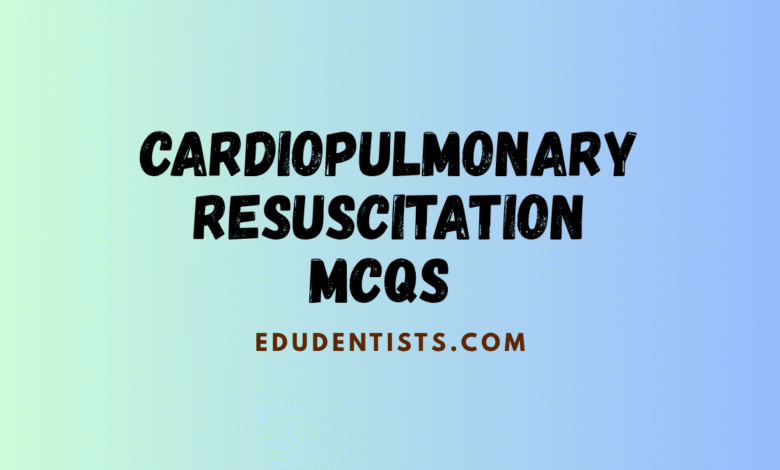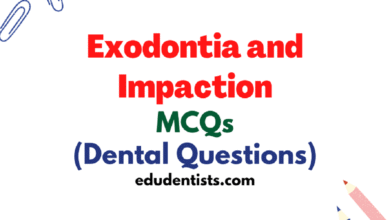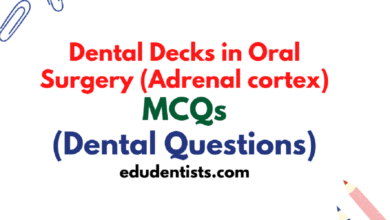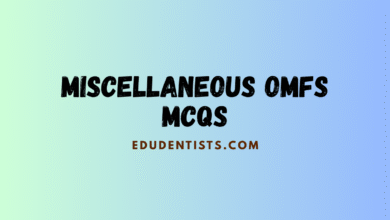Oral and Maxillofacial Surgery MCQs
Cardiopulmonary Resuscitation MCQs _ Oral and Maxillofacial Surgery MCQs
Cardiopulmonary Resuscitation MCQs _ Oral and Maxillofacial Surgery MCQs

Cardiopulmonary Resuscitation MCQs _ Oral and Maxillofacial Surgery MCQs
- Among the following which is the rescue breathing in adults?
A. 6 times/min
B. 18 times/min
C. 12 times/min
D. 24 times/min - The primary airway hazard for an unconscious patient in a supine position is:
A. Tongue obstruction
B. Bronchospasm
C. Laryngospasm
D. Aspiration - In CPR, if one incorrectiy applies pressure over the xiphoid process, the following may be injured:
A. Heart
B. Liver
C. Spleen
D. Lungs - During CPR sternum should be depressed:
A. Two inches every 5 seconds
B. 2 inches every second
C. 1 inch every 10 seconds
D. 3 inches every 5 seconds - Of the following which is the first step when initiating cardiopulmonary resuscitation:
A. Establish responsiveness
B. To establish an air way
C. A precardial thump
D. None of the above - Which of the following is true of cardiopulmonary resuscitation
A. Compression to ventilation ratio in two-person CPR is 5:1
B. Compression to ventilation ratio in single-person CPR is 15:2
C. Compression should be 60-80/minute in adults
D. Compressions should be 100/minute in children
E. All of the above - Standard airway for Ludwig’s angina:
A. Tracheostomy
B. Cricothyrotomy
C. Nasal intubation
D. Oral intubation - In an elective tracheostomy the entry should be made
A. Above the cricoid
B. Below the cricoid
C. Through the cricothyroid membrane
D. Laterally below the thyroid cartilage - Continuation of antibiotic medication in gram-negative soft tissue infections is required:
A. At least 2 days after all clinical signs of infection subside
B. Until acute symptoms of infection subside
C. For a minimum of 7-10 days
D. For a period of 21 days - Patient with idiopathic thrombocytopenic purpura (ITP) is most likely to have which of the following postoperative complications:
A. Infection
B. Haemorrhage
C. Oedema
D. Localised alveolar osteitis (dry socket) - One suspected rheumatoid arthritis of the TMJ. Helpful positive laboratory study would be:
A. Haematocrit elevation
B. GIT
C. Increased erythrocyte sedimentation rate
D. Tourniquet test (or) Hess test - Among the following which anaerobic organism is frequently responsible for oral and facial infection?
A. Staphylococcus aureus
B. Staphylococcus albus
C. Bacteroides fragilis
D. Streptococcus viridans - To drain pus from an abscess of the pterygomandibuiar space from an intraoral approach, the muscle most likely to be incised is the:
A. Buccinator
B. Temporal
C. Medial pterygoid
D. Lateral pterygoid - A patient came to dental clinic who has a pulse rate of 72, a respiratory rate of 15, a BP of 120/80, warm pink extremities and pupils that constrict during near accommodation. What is the most likely diagnosis?
A. Normal patient
B. Acute anxiety syndrome
C. Coronary artery disease
D. Myopia - At what diastolic pressure do you consider the patient to have significant hypertension? (mm Hg)
A. 110
B. 90
C. 85
D. 65 - Normal factor VIII levels in the blood is
A. 5.0-6.5 IU/mL
B. 3.0-4.5 IU/mL
C. 1.5-2.5 IU/mL
D. 0.5-1.5 IU/mL - Which of the following agent is of value in the post-operative care of haemophilic patients?
A. Vitamin K
B. Munsell’s solution
C. Aminocaproic acid
D. Factor 8 Cryoprecipitate - Of the following what would be the WBC range in mild infections
A. 4000-8000 cells/mm3
B. 24,000-30,000 cells/mm3
C. 15,000-20,000 cells/mm3
D. None of the above - Which of the following is first manifestation of complete respiratory obstruction?
A. Pronounced retraction of intercostal and supraclavicular spaces
B. Prolonged expiration
C. Cyanosis
D. None of the above. No changes in the patient - All of the following bones contain air sinuses except
A. Frontal
B. Nasal
C. Sphenoid
D. Ethmoid - Selective neck dissection includes the following criteria:
A. All Cervical lymph nodes are removed
B. All lymph nodes are removed
C. Some lymph nodes removed by radial neck dissection with preservation of one or more non-lymphatic structures i.e. SAN, SCM, IJV
D. Additional lymph node and non-lymphatic structure related to non-lymphatic structure is removed - The functional neck dissection the following structures are preserved
A. Sternomastoid muscle, spinal accessory nerve and internal jugular vein
B. Sternomastoid muscle, external jugular vein and internal jugular vein
C. Submandibular gland, thoracic duct and facial artery
D. Strap muscles, facial artery and facial vein - A typical protein requirement for a critically ill patient would be
A. 1.5 to 2.0 g/kg per day
B. 0.25 to 0.3 g/kg per day
C. 2.5 to 3.5 g/kg per day
D. 0.15 to 0.20 g/kg per day - Repositioning of pre-maxilla is a must before cleft lip and palate surgery as it:
A. Supports Base for lip suture
B. Helps in Feeding
C. Helps in proper alignment of permanent central incisors
D. Helps in preventing speech defects - Which is the best method to counteract severe acidosis following cardiopulmonary resuscitation?
A. Administration of adrenaline by IV route
B. Administration of sodium bicorbonate intravenously
C. Administration of adrenaline intramuscularly
D. No treatment is necessa because it is self limiting - During CPR, the chest compression should be
A. 2 inch/second
B. 1 inch/second
C. 2 inch/5 seconds
D. 1 inch/5 seconds - If efforts in cardiopulmonary resuscitation are effective there will be
A. Constriction of pupils
B. Dilatation of pupils
C. Immediate hypertension
D. None of the above - In external cardiac compressions, the compression relaxation cycle should be repeated…
A. 100 times per minute
B. Twice per second
C. 60 times per minute
D. 80 times per minute - Which of the following may result in interuptions in cardiac compressions?
A. Little changes in blood flow and blood pressure
B. A reduction of the blood flow and blood pressure to zero
C. Carbon dioxide buildup in the lungs
D. None of the above - Among the following which always indicates obstruction to the airway?
A. Increased respiratory rate
B. Increased pulse rate
C. Stertorous breathing
D. Decreased blood pressure - To perform tracheostomy entry should be made at the
A. Cricothyroid ligament
B. Thyroid membrane
C. Thyroid notch
D. Cricoid cartilage - Among the following which variable has the greatest significance in antibiotic management of dental infection:
A. Susceptibility of the organism
B. Route of administration
C. Antigenicity of the antibiotics
D. Specific antibody titer of the host - After I & D of an abscess, the infectious process has failed to regress in spite of the patient being on high doses of an antibiotic, it would be wise to:
A. Repeat culture and sensitivity tests.
B. Insert a large drain.
C. Augmenting antibiotic action by administration of parenteral proteolytic enzymes.
D. Debride and irrigate the area with a fibrinolytic agent. - After administration of inferior alveolar nerve block to an addict, the needle accidentally pricks the dentist’s finger. Subsequently the dentist developed malaise, weakness, and elevated SGOT and SGPT. Most probably he contacted which of the following diseases?
A. Serum hepatitis
B. Infectious hepatitis
C. Infectious mononucleosis
D. Primary syphilis - After a depressed fracture of zygomatic arch, mandibular movement is restricted. The most probable reason is:
A. Disruption of TMJ
B. Spasm of the lateral pterygoid muscle
C. Mechanical impingement of the fracture fragment on the coronoid process
D. Splinting action of masseter and medial pterygoid muscle - Among the following which way best protects from the toxic aspects of a local anaesthetic?
A. Take a thorough medical history
B. Have oxygen available
C. Use an aspirating technique
D. Use the lowest possible concentration of the local anaesthetics - Which of the following is significant in a patient with renal transplant?
A. Haematocrit 37%
B. Cholesterol 200 mg%
C. WBC -2000
D. BUN 21% - Which of the following signs/symptoms does not suggest postoperative infection?
A. Firm, tender swelling
B. Localized pitting oedema
C. Temperature elevation
D. Increasing or persisting pain - Which of the following values should be taken if there is excessive blood loss after a surgical procedure?
A. Haematocrit and platelet count
B. WBC and RBC count
C. Haemoglobin and Haematocrit
D. Platelet and RBC count - Which of the following is best treatment for hypoglycaemia in an unconscious diabetic patient
A. Intravenous administration of 50% dextrose in water
B. Administration of oral carbohydrates
C. Sublingual injection of 50% dextrose
D. None of the above. No treatment is necessary. - Near accurate body temperature can be obtained if one measures
A. Orally
B. Axillary
C. Rectally
D. Temperature over forehead - Usually acute pyogenic bacterial infection produces
A. Neutropenia
B. Lymphocytic leukocytosis
C. Neutrophilic leukocytosis
D. Eosinophilia - Surgery of the cleft lip repair should be carried out at:
A. 2-5 weeks
B. 5-12 weeks
C. 6-12 m
D. After I year





